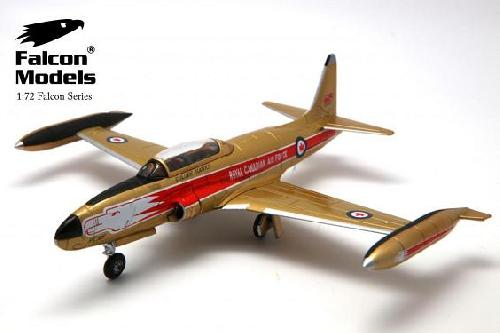1 in stock
£56.99
1 in stock
Lockheed T-33 Silver Star s/n 21500 of the Golden Hawks aerobatic team of the Royal Canadian Air Force. Complete with opening canopy, optional undercarriage positions and stand. The Golden Hawks primary aircraft was the Sabre Mk5, which they operated between 1959 and 1964. The T-33 operated as their support aircraft.
Length 6.25 inches Wingspan 6.5 inches
The Lockheed T-33 Shooting Star is an American-built jet trainer aircraft. It was produced by Lockheed and made its first flight in 1948, piloted by Tony LeVier. The T-33 was developed from the Lockheed P-80/F-80 starting as TP-80C/TF-80C in development, then designated T-33A. It was used by the U.S. Navy initially as TO-2 then TV-2, and after 1962, T-33B. Despite its vintage, the venerable T-33 still remains in service worldwide.
The T-33 (aka “T-Bird”) was developed from the Lockheed P-80/F-80 by lengthening the fuselage by slightly over three feet and adding a second seat, instrumentation and flight controls. It was initially designated as a variant of the P-80/F-80, the TP-80C/TF-80C.
Design work for the Lockheed P-80 began in 1943 with the first flight on 8 January 1944. Following on the Bell P-59, the P-80 became the first jet fighter to enter full squadron service in the United States Army Air Forces. As more advanced jets entered service, the F-80 took on another role – training jet pilots. The two-place T-33 jet was designed for training pilots already qualified to fly propeller-driven aircraft.
Originally designated the TF-80C, the T-33 made its first flight on 22 March 1948 with US production taking place from 1948 to 1959. The US Navy used the T-33 as a land-based trainer starting in 1949. It was designated the TV-2, but was redesignated the T-33B in 1962. The Navy operated some ex-USAF P-80Cs as the TO-1, changed to the TV-1 about a year later. A carrier-capable version of the P-80/T-33 family was subsequently developed by Lockheed, eventually leading to the late 1950s to 1970s T2V-1/T-1A SeaStar. A total of 6,557 Shooting Stars were produced, 5,691 by Lockheed.
The two-seater T-33 proved ideal as an advanced trainer, and it has been used for such tasks as drone director and target towing. The U.S. Air Force began phasing the T-33 out of front line pilot training duties in the Air Training Command in the early 1960s as the T-37 Tweet and T-38 Talon aircraft began replacing it under the Undergraduate Pilot Training (UPT) construct. Similar replacement also occurred in the U.S. Navy with the TV-1 (also renamed T-33 in 1962) as more advanced aircraft such as the T-2 Buckeye came on line. USAF and USN versions of the T-33 soldiered on into the 1970s and 1980s with USAF and USN as utility aircraft and proficiency trainers, with some of the former USN aircraft being expended as full scale aerial targets for air-to-air missile tests from naval aircraft and surface-to-air missile tests from naval vessels. Several T-33s were assigned to USAF F-101 Voodoo, F-102 Delta Dagger and F-106 Delta Dart units, to include similarly equipped Air National Guard units, of the Aerospace Defense Command as proficiency trainers and practice “bogey” aircraft. Others later went to Tactical Air Command and TAC-gained Air National Guard F-106 and F-4 Phantom II units in a similar role until they were finally retired.
Some T-33s retained two machine guns for gunnery training, and in some countries, the T-33 was even employed as a combat aircraft: the Cuban Air Force used them during the Bay of Pigs Invasion, scoring several kills. The RT-33A version, reconnaissance aircraft produced primarily for use by foreign countries, had a camera installed in the nose and additional equipment in the rear cockpit. T-33s continued to fly as currency trainers, drone towing, combat and tactical simulation training, “hack” aircraft, electronic countermeasures and warfare training and test platforms right into the 1980s.
The T-33 has served with over 30 nations, and continues to operate as a trainer in smaller air forces. Canadair built 656 T-33s on licence for service in the RCAF – Canadian Forces as the CT-133 Silver Star while Kawasaki manufactured 210 in Japan. Other operators included Brazil, Turkey and Thailand which used the T-33 extensively.
In the 1980s, an attempt was made to modify and modernize the T-33 as the Boeing Skyfox, but a lack of orders led to the cancellation of the project. About 70% of the T-33s airframe was retained in the Skyfox, but it was powered by two Garrett AiResearch TFE731-3A turbofan engines.
In the late 1990s, 18 T-33 Mk-III and T-33 SF-SC from the Bolivian Air Force went to Canada to be modernized at Kelowna Flightcraft. New avionics were installed, and detailed inspection and renewal of the fuselage and wings were performed. Most of the aircraft returned in early 2001 and remain operational.
A limited number of T-33s have found their way into private hands; some current owners: Michael Dorn of Star Trek: The Next Generation fame, Canadair T-33. and northern California based Greg Colyer of the T33 Heritage Foundation who operates a Canadair CT-133 Silver Star monikered “Ace Maker”. Various T-33s are based out of Wendover airport, Utah. Kay Eckhardt has his T-33s based at Wendover they are a Blue Angels variant and a baremetal USAF version.
On 6 September 2006, Imperial War Museum Duxford’s Canadair T-33 (G-TBRD), owned by the Golden Apple Trust, was destroyed in a takeoff accident;[citation needed] the crew survived. G-TBRD was the first jet warbird to be operated from Duxford, arriving in 1975; it was originally registered as G-OAHB.
In 2008, several T-33s in storage at CFB Mountain View, an old World War II era RCAF base south of Trenton, Ontario, were sold to various private collectors. Six airplanes were purchased by a newly formed museum out of London, Ontario, called the Jet Aircraft Museum (JAM), associated with the Canadian Harvard Aircraft Association, which purchased the aircraft on behalf of JAM. The six airplanes, formerly designated #133346, now C-FUPM; #133500, now C-FUPO; and #133573, now C-FUPP, as well as #133052, #133263 and #133441, will be flown in airshows and for memorials across Canada and in parts of the USA. Other T-33s have also been sold to various US and Canadian buyers
In 2010, a T-33 Shooting Star owned by Boeing was used as a chase aircraft during the maiden flight of the Boeing 787 and Boeing 747-8
| Weight | 0.8 kg |
|---|

